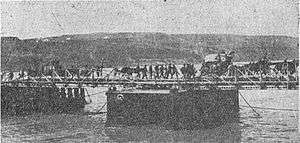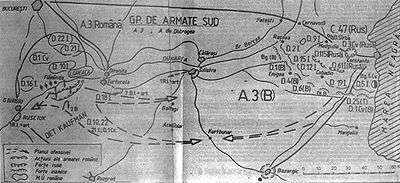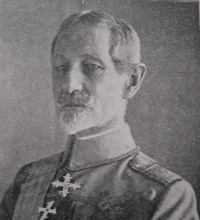Flămânda Offensive
| Flămânda Offensive | |||||||
|---|---|---|---|---|---|---|---|
| Part of the Romanian Campaign of World War I | |||||||
 Romanian 10th Division crossing the Danube at Flămânda/Ryahovo | |||||||
| |||||||
| Belligerents | |||||||
|
|
| ||||||
| Commanders and leaders | |||||||
|
|
| ||||||
| Casualties and losses | |||||||
| Unknown |
1 river monitor grounded 1 river monitor damaged 1 patrol boat damaged 2 barges destroyed 1 barge damaged 3 killed 5 wounded Unknown Unknown | ||||||
The Flămânda Offensive (or Flămânda Maneuver, which took place between 29 September and 5 October 1916, was an offensive across the Danube mounted by the Romanian 2nd Army during World War I. The battle represented a consistent effort by the Romanian Army to stop the Central Powers south offensive led by August von Mackensen. The battle ended as a tactical victory for the Central Powers.
Background


Romania begun its World War I in August 1916, when Romanian forces invaded Transylvania passing the border on the Carpathian Mountains. The Romanian forces quickly defeated the small number of Austro-Hungarian forces based in the border area and started their advance into Austro-Hungarian territory, but they were halted soon. Meanwhile, a Central Powers force comprising Bulgarian, German and Turkish troops and led by August von Mackensen entered Dobruja in southeastern Romania.[1]
Facing more serious threats than expected, the Romanian Crown Council decided to reinforce the 3rd Army, led by General Alexandru Averescu, by 150,000 men. Averescu consequently was put in charge of an army group consisting of the 3rd Army and the 50,000 men Army of the Dobruja commanded by general Andrei Zayonchkovski, comprising 17 divisions and planned to counterattack Mackensen's forces across the Danube River from behind. The plan was to attack the Central Powers forces from the rear by crossing the Danube at Flămânda, while the front-line Romanian and Russian forces were supposed to launch an offensive southwards towards Cobadin and Kurtbunar (today Tervel, Dobrich Province). The idea was to cut off Mackensen's army from its bases in northern Bulgaria.[1]
The battle
The attack commenced on 29 September on a 50 miles (80 km) wide front from Flămânda, near Oltenița, to Zimnicea in the direction of Mackensen's western flank, with the Romanian forces enjoying superiority in numbers of infantry personnel and artillery equipment. However, the Romanian struggle to cross the Danube was slowed by the Austro-Hungarian Navy's Danube Flotilla.[1]
On October 1, two Romanian divisions crossed the Danube at Flămânda and created a bridgehead 14 kilometer-wide and 4 kilometer-deep.[2] This area was expanded on the following day, with eight Bulgarian settlements ending up in Romanian hands.[3] The Romanian crossing of the Danube was contested by the Danube Flotilla of the Austro-Hungarian Navy, commanded by Captain Karl Lucich.[4] The first Austro-Hungarian warships to enter combat were the patrol boats Barsch and Viza, on the morning of 2 October. Barsch was shelled by Romanian artillery and lost her steering, along with 3 of her crew killed and 5 wounded. The two patrol boats retreated, only to be replaced by the river monitors Bodrog and Körös. The two warships were unable to shatter the bridge with their guns.[5] Romanian artillery fired at Bodrog, which took 5 hits and was forced out of the battle. Körös was also shelled by the Romanians, taking 12 hits and ran aground after her steam lines were severed by Romanian artillery.[6] An Austro-Hungarian coal barge was also shelled and damaged by Romanian artillery. Due to the deteriorating situation in Transylvania, General Averescu decided to cancel the offensive, ordering his troops back to the Romanian side of the river on October 3, after repairing the damaged parts of the bridge.[7] Two Austro-Hungarian barges were blown up and destroyed by Romanian forces on the night of that same day. The Austro-Hungarian flotilla finally left the scene in the early hours of 4 October, after being informed that the Romanian river monitors were approaching the area.[8]
Aftermath
The Danube remained a barrier to military operations until half of Mackensen's army crossed it in late November, 1916.
References
Notes
- 1 2 3 Tucker and Roberts, p. 418
- ↑ Tucker, p. 419
- ↑ Michael B. Barrett, Prelude to Blitzkrieg: The 1916 Austro-German Campaign in Romania, p. 136
- ↑ Michael B. Barrett, Prelude to Blitzkrieg: The 1916 Austro-German Campaign in Romania, p. 137
- ↑ Michael B. Barrett, Prelude to Blitzkrieg: The 1916 Austro-German Campaign in Romania, p. 139
- ↑ Michael B. Barrett, Prelude to Blitzkrieg: The 1916 Austro-German Campaign in Romania, p. 140
- ↑ Michael B. Barrett, Prelude to Blitzkrieg: The 1916 Austro-German Campaign in Romania, p. 142
- ↑ Michael B. Barrett, Prelude to Blitzkrieg: The 1916 Austro-German Campaign in Romania, p. 143
Bibliography
- Spencer Tucker, Priscilla Mary Roberts (2005). Encyclopedia of World War I. ABC-Clio. ISBN 1-85109-420-2.
External links
- (English) The Flămânda Maneuver on worldwar2.ro
Coordinates: 43°59′15″N 26°14′42″E / 43.98750°N 26.24500°E

